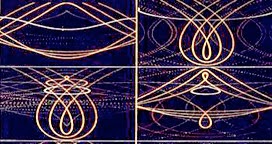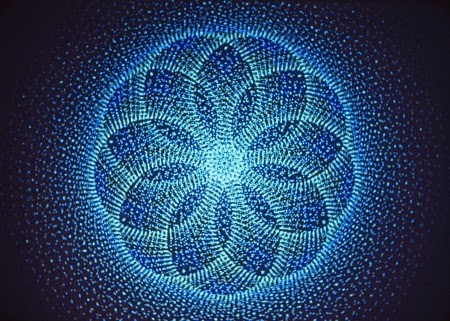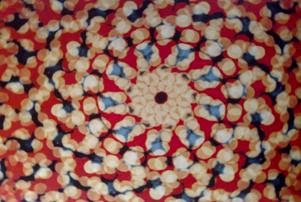Oddball Films presents Strange Sinema 84, a monthly screening of new finds, old gems and offbeat oddities from the archive. Drawing on his collection of over 50,000 16mm film prints, Oddball Films director Stephen Parr has compiled his 84th (and 7-year anniversary!) program of classic, strange, offbeat and unusual films. This installment, Strange Sinema 84: Holographic is an anthology of carefully crafted experimental films emphasizing dimensionality, spirituality, high technology and art of the 60s. We begin with Holography: Memories in Light (1985), a fascinating look at the invention, development, and use of holography in industry and art; from holographic space ships to a holographic Andy Warhol. We continue with the mesmerizing documentary Kinetic Art in Paris (1971), a viscerally challenging kaleidoscopic homage to light sound and motion featuring some of the world's foremost kinetic artists, and Art of the Sixties (1967), featuring the monumental soft sculptures of Claes Oldenburg, machine artist Len Lye, Les Levine's interactive environments, action painter-provocateur Jackson Pollock and more. Once again, we are screening a selection of Whitney films, featuring motion graphics pioneer John Whitney Sr., brother James and son Michael's work, all profoundly audacious and inspiring in their fluidity, motion and spiritual subtext. John Whitney's Arabesque (1975) is a legendary masterpiece of shimmering, oscillating waves set to the music of Persian composer Maroocheher Sadeghi. Michael Whitney's Binary Bit Patterns (1969) is a hypnotic psych-folk audiovisual experience that suggests a secret symbiosis between the digital and the organic as various Eastern graphic permutations appear, dissolve and undergo metamorphoses on the screen. Lapis (1965), made by a spiritualized James Whitney (one of only 7 films he created) and one of the most accessible experimental films ever made; Lapis was created with handmade cels evoking a single mandala moving within itself; its particles surge around each other in constant metamorphosis. Finally, we offer up 3 Rarely Seen Experimental Films. These wondrous top-secret surprises incorporate aspects of yoga, INFINITY and Indian mysticism, exploring the relationship between LIGHT, scientific theories as well as CHAKRA-based spirituality. These moving images reflect the actual visual and auditory phenomena the filmmaker experienced in heightened states of meditative concentration. Many of the films share certain images which the filmmaker regarded as "hieroglyphic-ideographic" visual units that express complex ideation not easily stated in verbal terms.
Date: Friday, January 23rd, 2015 at 8:00PM
Venue: Oddball Films, 275 Capp Street San Francisco
Web: http://oddballfilms.blogspot.com
Featuring:
Holography: Memories in Light (Color, 1985)
A fascinating look at the invention, development and use of holography in industry and art; from holographic space ships to a holographic Andy Warhol.
Kinetic Art in Paris (Color,1971)
The works of Kinetic artists Julio Le Parc, Victor Vasarely, John Rock Yvar aren’t the only things explored in detail in this ultra rare, quirky documentary that features music from the short-lived cult British pop duo White Trash. Viscerally challenging, this kaleidoscopic homage to light, sound, motion and restraint is quintessential viewing for anyone with a desire to be fascinated by anything…even if just for a moment. Don’t miss this!
The Art of the Sixties (Color, 1967)
This rarely seen documentary aired on CBS at the height of the revolutionary and hopeful changes sweeping the art world (not to mention the rest of society). The film takes an inside look at some of the leading figures in art during the decade, including rare glimpses into their studios and workshops. Highlights include soft-sculpture pop iconographer Claes Oldenburg who states “My work is not meant to be funny or even art, my work is just made to be important”, Jackson “The Dripper” Pollock, conceptualist Sol Lewitt, Les Levine, and other artists who have since become emblematic of the wild experimentation of and use of industrial processes (Rauschenberg’s silkscreens, Barnett Newman’s steel fabricated sculptures) of the 60s. We also follow pioneering filmmaker, sculptor and engineer Len Lye as he demonstrates his large-scale kinetic sound sculptures.
Arabesque (Color, 1975)
John Whitney‘s Arabesque, is considered by many to be the seminal computer film. Set to the music of Manoochelher Sadeghi, and created during a residency at IBM Whitney balanced science with aesthetics as he experimented with the eccentricities of Islamic architecture creating whirling, exotic flows of computer generated images. Arabesque was one of the first computer generated films that married technology and art is a focused, cinematic manner. Working with his early home-made computerized motion-control set-up, Whitney could produce a variety of innovative designs and metamorphoses of text and still images, which proved very successful in advertising and titling of commercial projects. He also did various commercial assignments including the title design for Hitchcock's feature Vertigo (in association with Saul Bass), and the preparation (in association with Charles Eames) of a seven-screen presentation for the Buckminster Fuller Dome in Moscow.
Binary Bit Patterns (Color, 1969) The spectacular, fast-paced film features quilt-like tapestries of polyhedral and crystalline figures pulsating and multiplying with a kind of universal logic eliciting a hypnotic, trancelike effect from the viewer. This film echoes a preoccupation with the mandala image and the interest in Eastern meditative philosophy that is seen in the work of the whole Whitney family. Employing computer generated imagery with optically introduced color and flicker effects, Michael Whitney creates a hypnotic, psych-folk audiovisual experience that suggests a secret symbiosis between the digital and the organic as various Persian inflected graphic permutations appear, dissolve and undergo metamorphoses on the screen. With original sound-score.
Lapis (Color, 1965)
This film, by film pioneer James Whitney consists entirely of dot patterns. Like a single mandala moving within itself, the particles surge around each other in constant metamorphosis, a serene ecstasy of what Jung calls "individuation." For 10 minutes, a succession of beautiful designs grows incredibly, ever more intricate and astounding; sometimes the black background itself becomes the pattern, when paths are shunned by the moving dots. A voluptuous raga soundtrack by Ravi Shankar perfectly matches the film's flow, and helped to make LAPIS one of the most accessible "experimental films" ever made.
The images were all created with handmade cels, and the rotation of more than one of these cels creates some of the movements. John Whitney Sr. had built a pioneer computerized animation set-up—the prototype for the motion-control systems that later made possible such special effects as the "Star Gate" sequence of 2001. James used that set-up to shoot some of his handmade artwork, since it could ensure accuracy of placement and incremental movement.
For more information about John, James and Michael Whitney’s work:
Another link to James Whitney’s influences and life:
Finally, we offer up 3 Rarely Seen Experimental Films. These wondrous top-secret surprises incorporate aspects of yoga, INFINITY and Indian mysticism, exploring the relationship between LIGHT, scientific theories as well as CHAKRA-based spirituality. These moving images reflect the actual visual and auditory phenomena the filmmaker experienced in heightened states of meditative concentration. Many of the films share certain images which the filmmaker regarded as "hieroglyphic-ideographic" visual units that express complex ideation not easily stated in verbal terms.
|
Curator's Biography:
Stephen Parr’s previous programs have explored the erotic underbelly of sex-in-cinema (The Subject is Sex), the offbeat and bizarre (Oddities Beyond Belief), the pervasive effects of propaganda (Historical/Hysterical?) and oddities from his archives (Strange Sinema). He is the director of Oddball Film+Video and the San Francisco Media Archive (www.sfm.org), a non profit archive that preserves culturally significant films. He is a co-founder of Other Cinema DVD and a member of the Association of Moving Archivists (AMIA) where he is a frequent presenter.
|
|
About Oddball Films
Oddball films is the film component of Oddball Film+Video, a stock footage company providing offbeat and unusual film footage for feature films like Milk, documentaries like The Summer of Love, television programs like Mythbusters, clips for Boing Boing and web projects around the world.
Our films are almost exclusively drawn from our collection of over 50,000 16mm prints of animation, commercials, educational films, feature films, movie trailers, medical, industrial military, news out-takes and every genre in between. We’re actively working to present rarely screened genres of cinema as well as avant-garde and ethno-cultural documentaries, which expand the boundaries of cinema. Oddball Films is the largest film archive in Northern California and one of the most unusual private collections in the US. We invite you to join us in our weekly offerings of offbeat cinema.










